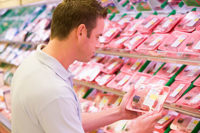Labeling the Issue
By Tom Wray, Associate Editor
Companies look at the changing world of labels and learn to adapt.
Labeling and coding can sometimes be an overlooked part of the meat packaging process. It just doesn’t seem to get that much attention.
Still, it is a very important part of the whole process. From determining freshness to keeping track of inventory to providing health information, labels and bar codes are something that every company needs to pay attention and find the best solution possible for their particular situation.
Luckily, there are several companies that have made it their mission to create the most effective labeling and coding solutions for processors. The two biggest problems for businesses in relation to labels and coding is keeping control at warehouses and scanning outside bar codes, says Patrick Pilz, CEO of CSB-System International.
“Almost everybody that ships product via an external warehouse has challenges with this, almost all lose the view on serial numbers,” he states. Making things more difficult are that not every warehouse has the same system capabilities and there are differences in bar-coding when using imported beef.
“A lot of packers make the extra step to re-label, which is costly and time-consuming, and there are better ways of doing what they need to do,” Pilz continues.
Pilz says that companies in the meat industry shouldn’t try to fix these issues with in-house computer technology, an opinion shared by others in labeling.
“A lot of people in the meat industry don’t understand computer technology very well, neither should they nor need they,” he says.
William F. Altenphol of Computerway Food Systems shares a similar opinion. “Sadly, we often see companies who have jumped into their own in-house ‘computer technology’ solutions to these problems because it ‘looks easy’ or because they perceive that it may be too expensive to bring in experts,” Altenphol explains. “Nine times out of 10, we see that they have fallen into the same traps as other companies. They end up spending twice the money, three times the time and four times the aggravation trying to implement something that they should never have attempted to do.”
In other words, leave it to the experts.
Pilz adds that CSB Systems products step up and help things out.
“We now extend our business applications to all kinds of platforms, so that we not only run on so-called RF-Guns, but the same application can also run on cell phones,” explains Pilz. That means that means a company’s sales reps can check the shipping status of a delivery from their desks or phones. Even better, so can the customer over the Internet. Furthermore, changes are coming over the horizon.
“The future belongs to RFID (radio frequency identification),” declares Pilz. “We have practical solutions in this field that work, and we are collecting a lot of experience.
“Eventually, this will be a replacement for bar-coding and scanning, but people that apply this technology now get burned most of the time,” he says. “We are actively developing technology that works for the industry and will share our insights with people that are interested.”
CSB Systems isn’t alone in efforts to improve labeling. The Bell-Mark Corporation is doing its part too.
“Our contributions to the meat industry for almost 50 years have greatly impacted how code dating and printing has developed,” says Glenn C. Breslauer, director of marketing and IT for the company. “Our newest innovation for the meat industry has been the development of the EasyPrint X harsh Environment Thermal Transfer which was the first IP65 rated thermal transfer printer designed specifically for the meat industry.”
The machine allows customers to take advantage of the clear printing other markets have enjoyed.
““From our very first ink coders to the variable data printing technologies of the EasyPrint X, innovative development will always be a high priority for Bell-Mark,” explains Breslauer.
Videojet Technologies Inc. keeps its focus on printing, though it also has been working on RFID. “It’s happened monumentally slower than planned,” says David Allen, business unit manager for secondary packaging for Videojet. The company’s biggest goal is making current technologies adaptable for customers.
“The macro trend is that customers need and want to put more information on packaging either because of regulation or they’re going to get regulated,” explains Allen.
Scott Benigni, continuous inkjet (CIJ) project manager for Videojet adds that a lot of customers are including tracking information, even shipping codes, so that if there’s a recall, the company can track exactly who produced the product and from where it came. Videojet also is looking at ways to keep the production lines moving along, even at increased paces.
“Production lines are going faster, and customers don’t want coding equipment to slow that down,” says Benigni, “How to jam all this information on and make the line go faster [is the challenge].”
One example of a product that helps address that demand is the newly launched Excel DN inkjet printer, with twin line code.
“It really meets the throughput needs of customers with the more bar code, more logo capability that our customers are requesting,” he continues. Plus, it’s wash down capable in the line, a must for the meat industry.
Another demand Videojet has worked on meeting is the increase in popularity of flexible packaging, Allen says. The company has developed products that can allow for printing on plastic and foam trays and wrappings..
An interesting twist on labeling that some processors have taken up is doing without labels entirely and printing all necessary information direction on the packaging.
“That has a couple of advantages,” says Allen. “First of all, a label is a contact loader and rife with opportunities for mayhem. You need reams of paper to keep the labeling going. There’s a lot of white space.”
Printing directly on the box, he says, one-sixth of the ink is used. Plus you avoid all the other drawbacks of labels.
At CFS Lifecycle Performance, efficiency is viewed as the big challenge in labeling.
“Labelers are one of the biggest downtime sources in a highly automated packaging process,” states Steffen Bamberger, product management-thermoformers. Further challenges include the integration of labeling technology into already existing systems, proper label placement on packaging and, of course, hygiene tops the rest.
Bamberger points out that his company’s web labelers address all of these issues. Plus, CFS can offer solutions for downtime reduction via ‘on-the-fly’ changeover mechanisms, he adds.
“CFS’ main focus market is the protein business all over the world where the meat industry is an important part,” he concludes. “We can offer multiple solutions from the raw product up to the final labeled and/or printed package.”
Marel Food Systems looks at the basics in their concerns over labels.
“There’s always a matter of getting a good label to adhere to various packing materials,” says Jeff Ray, marketing manager for Marel Food Systems. “And since the case-ready industry is growing so big, [retailers] want everything to come out of the box and onto the shelf.”
That means that the labels have to be high quality and have good adhesion whatever the packaging material is, which can be a challenge in some environments.
Marel’s labeling focus lays in making sure that products are retail-ready with accurately placed labels. “We have the highest speed and accuracy, with the most versatility as well,” he says.
Marel Food System’s Delford line is built to handle these challenging applications and builds labelers that adapt to customized labels. That’s especially important for whole-muscle products.
“Obviously that’s going to change per package,” says Ray. “It truly goes right on the shelf and ready for the check-out counter.”
For its part, Koch Equipment LLC’s focus is all on hygiene.
“From the standpoint of labeling equipment, the issues we are working to resolve are those associated with equipment sanitation and ease of equipment operation,” says Tom Ritter, labeling product line manager for Koch. “Increasing changes in the labor workforce require that the operation and maintenance of equipment be performed by workers with limited knowledge or working exposure to automated equipment.”
Ritter goes on to say that the company prides itself on staying ahead of the curve on innovation. “Our recent launch of the Matrix series of package and film labelers [provides] the most sanitary, high-speed, accurate and dependable labeler on the market of the harshest meat packaging environments,” he states.
The company also helps processors deal with the challenges brought on by the need for flexibility and the need to change labels quickly. “In today’s world of co-packing and production and running multiple marketing brands, we understand the need for flexibility and quick changeover,” he says.
That need for flexibility leads other companies as well, including Computerway Food Systems. Altenphol, president of the company, says RFID is what’s getting attention; many clients are requiring things such as secondary bar-coded labels for each retailer.
“We see a continued increase in the demand for customized labeling of cases stemming from major retailers to suit their traceability and product movement needs,” he explains. “This customer demand requires additional printers and additional software capacity to handle order-specific production within a processing plant environment.”
Computerway takes aim at those requirements. Altenphol says that his company handles these by using its technology and newly developed “Order Management Software” modules. Some of the company’s customers use the “Q” Enterprise system to manage specifications and label designs at the corporate level. All of these allow for the needed flexibility.
“Our expertise in computer technology, coupled with our 20 years of experience dealing with thousands of different customer sites has taught us a trick or two that we are able to bring forward as possible solutions for any company,” Altenphol continues. Computerway’s systems are designed to work with most existing equipment and with accounting or ERP systems.
“These features reduce the cost, complexity and the implementation time for processors to enjoy the benefits of accurate, real-time inventory information,” he explains.
The company is still working on new products as the market continues to change. “Specifically, as computer technology streaks forward, we are continually developing news systems and new solutions that would have been prohibitive or even impossible even five years ago,” says Altenphol.

